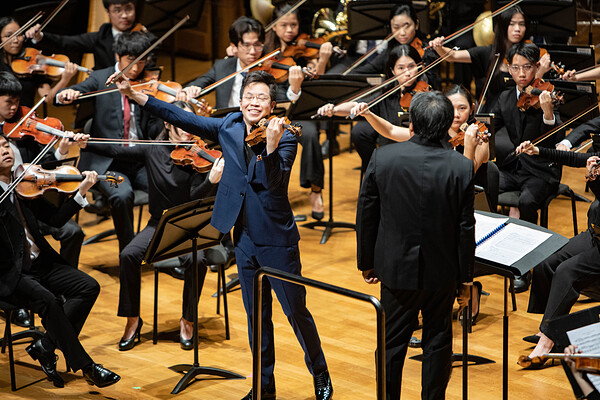Press
Review
Violinist Paul Huang is a Rising Star in Classical Music

Remember the name. Young Taiwanese-American violinist Paul Huang will light up the classical musical world in years to come, much like his older compatriot Cho-liang Lin did a generation before.
His most recent visit to Singapore included a chamber concert at the Conservatory and two concerto performances at the School of the Arts. The former opened with an informal fireside chat, where he gave commonsensical advice to younger musicians in attendance. "Do it only if you cannot live without it," was his take-home message about pursuing a professional career in music.
That credo was fully realised in a rare performance of French composer Ernest Chausson's Concert For Violin, Piano And String Quartet (Op. 21).
Partnered with American-Chinese pianist Ning An and the Cave String Quartet - comprising violinists Viktoria Ivaylova Marinova and Syu Cheng-Yi, violist Caitlin Chin Kai Li and cellist Ren Yuxiao - this unusual 40-minute-long work oozed passion from every pore.
Its configuration was extraordinary, alternating between being a piano quintet, a violin-piano duo and a duo accompanied by string quartet, all within its symphonically conceived four movements.
The performers' roles seemed as fluid as its idioms, which relived the Liszt-Wagner metamorphosis of motifs, while balancing Gabriel Faure's Belle Epoque niceties and Cesar Franck's austerity.
Most important was the cohesion achieved between soloists Huang and An, in highly virtuosic parts, and the young student quartet, which grew in confidence as the work proceeded. The rollicking finale, played as if their collective lives depended on it, deservedly brought out long and loud cheers.
Much more familiar was Pyotr Tchaikovsky's evergreen Violin Concerto In D Major (Op. 35), performed by Huang and the Orchestra of the Music Makers (OMM) led by Chan Tze Law.
In his hands, this warhorse sound freshly minted. His solo entry was arresting and made one sit up.
Exhibiting faultless intonation, a gorgeous big tone and rich vibrato, his vision was redolent of great masters of the past - Jascha Heifetz, Nathan Milstein and David Oistrakh, just to name a few. The orchestra was equally responsive to every nuance and feint, supporting him to the hilt yet unafraid to exude passion and fervour in this unabashedly Romantic music.
There were moments in the Canzonetta slow movement when Huang chose to exercise rubato, and the ever-alert accompaniment never skipped a beat. Then came the all-guns-blazing finale, catching fire and radiating white-hot excitement until the very last chord.
Huang clearly looked like he enjoyed himself, and followed the romp with Fritz Kreisler's Scherzo-Caprice (without its preceding Recitativo) as brilliant encore.
The balance of OMM's programme was of showpieces united by the common theme of love won and lost. Richard Wagner's Overture to The Flying Dutchman opened the evening, where the brass truly shone, reminding this was the orchestra that premiered the first two operas of the Ring cycle in Singapore. Woodwinds got their turn in the limelight for the opening of Tchaikovsky's Romeo And Juliet Fantasy-Overture, after which soaring strings took over for the work's unforgettable love theme. George Gershwin's Porgy And Bess: A Symphonic Picture by master orchestrator
Robert Russell Bennett was a showcase for an ever greater variety of sounds, including multiple percussion instruments, three saxophones and a keyboard simulating a banjo.
Hearing popular melodies like Summertime, I Got Plenty O' Nuttin', It Ain't Necessarily So and Lawd I'm On My Way dressed up in Hollywood glitz and glamour was a perfect way to close an evening of fine music.